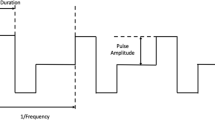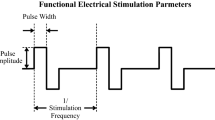Abstract
This Chapter provides an overview of the historical background of functional electrical stimulation (FES) and the different therapeutic forms and terminologies commonly used in electrical stimulation (ES) for neurorehabilitation.
Access this chapter
Tax calculation will be finalised at checkout
Purchases are for personal use only
Similar content being viewed by others
References
Moe J, Post H. Functional electrical stimulation for ambulation in hemiplegia. J Lancet. 1962;82:285–8.
Liberson W, Holmquest H, Scot D, Dow M. Functional electrotherapy: stimulation of the peroneal nerve synchronized with the swing phase of the gait of hemiplegic patients. Arch Phys Med Rehabil. 1961;42:101–5.
Popovic M, Masani K, Micera S. Neurorehabilitation technology, 2. Aufl. Springer Science, s.l.; 2016
Doucet B, Lam A, Griffin L. Neuromuscular electrical stimulation for skeletal muscle function. Yale J Biol Med. 2012;85:201–15.
van Kerkhof P. Das Elektrotherapieskript. Muskelstimulation wwwPhysiosupportorg 12 October; 2013:S1–260.
Eraifej J, et al. Effectiveness of upper limb functional electrical stimulation after stroke for the improvement of activities of daily living and motor function: a systematic review and meta-analysis. Syst Rev. 2017;6(1):40.
Fields R, et al. Electromyographically triggered electric muscle stimulation for chronic hemiplegia. Arch Phys Med Rehabil. 1987;68:407–14.
Kraft G, Fitts S, Hammond M. Techniques to im- prove function of the arm and hand in chronic hemiplegia. Arch Phys Med Rehabil. 1992;73(3):220–7.
Iruthayarajah J, et al. Evidence-based review of stroke rehabilitation. London: Evidence-Based Review of Stroke Rehabilitation; 2018.
Monte-Silva K, et al. Electromyogram-related neuromuscular electrical stimulation for restoring wrist and hand movement in poststroke hemiplegia: a systematic review and meta-analysis. Neurorehabil Neural Repair. 2019;33(2):96–111.
Coscia M, et al. Neurotechnology-aided interventions for upper limb motor rehabilitation in severe chronic stroke. Brain. 2019;142:2182–97.
Bossert F-P, Vogedes K. Elektrotherapie, Licht- und Strahlentherapie, 3. Aufl: Elsevier GmbH, Urban & Fischer, München; 2014.
Willand M, et al. Electrical muscle stimulation elevates intramuscular BDNF and GDNF mRNA following peripheral nerve injury and repair in rats. Neuroscience. 2016;15(334):93–104.
Golaszewski S, Frey V. Neuromodulation in der Neurorehabilitation nach Schlaganfall. Jatros Neurol Psychiartrie. 2019;3:12–8.
von Lewinski F, et al. Efficacy of EMG-triggered electrical arm stimulation in chronic hemiparetic stroke patients. Restor Neurol Neurosci. 2009;27(3):189–97.
Kapadia N, et al. Functional electrical stimulation therapy for grasping in traumatic incomplete spinal cord injury: randomized control trial. Artif Organs. 2011;35:212–6.
Schick T, et al. Synergy effects of combined multichannel EMG-triggered electrical stimulation and mirror therapy in subacute stroke patients with severe or very severe arm/hand paresis. Restor Neurol Neurosci. 2017;35(3):319–32.
Winstein C, et al. Guidelines for adult stroke rehabilitation and recovery: a guideline for healthcare professionals from the American Heart Association/American Stroke Association. Stroke. 2016;47(6):e98–e169.
Alon G, Levitt A, McCarthy P. Functional electrical stimulation (FES) may modify the poor prognosis of stroke survivors with severe motor loss of the upper extremity: a preliminary study. Am J Phys Med Rehabil. 2008;87(8):627–36.
Hara Y, Ogawa S, Tsujiuchi K, Muraoka Y. A home-based rehabilitation program for the hemiplegic upper extremity by power-assisted functional electrical stimulation. Disabil Rehabil. 2008;30(4):296–304.
Moller P. Review: electric fish. Bioscience. 1991;41(11):794–6.
Hackmann W. Electrostatic machine. In: Bud R, editor. An historical encyclopedia. Instruments of science. New York: Garland; 1998. p. S221–4.
Lommel E. Ewald Georg von Kleist, Allgemeine Deutsche Biographie. Allgemeine Deutsche Biographie. 1882;16:112–3.
Jallabert L. Experimenta electrica usibus medicis applicata. J. R. im Hof, 312 S. Pappband der Zeit, Basel; 1750
Hartmann JF. Die angewandte Elektrizität bei Krankheiten des menschlichen Körpers. s.n., Hannover; 1770
Schäffer JG. Die Elektrische Medicin oder die Kraft und Wirkung der Elektricität in dem menschlichen Körper und dessen Krankheiten besonders bei gelähmten Gliedern aus Vernunftgründen erläutert und durch Erfahrungen bestätigt, 2. Aufl. Johann Leopold Montag, s.l. 1766
von Oettingen A, Galvani A, Volta A (Hrsg). Abhandlung über die Kräfte der Elektricität bei der Muskelbewegung: (Comm. Bonon. Sc. et Art. Inst. et Acad. T. 7); (1791)/von Aloisius Galvani. Untersuchungen über den Galvanismus: (1796–1800)/von Alessandro Volta, 2. Aufl. Bolognia (Hrsg), Thun/Frankfurt am Main; 1996
Duchenne G-B. Mécanisme de la physionomie humaine ou analyse électro-physiologique de l’expression des passions. Deuxième édition ed. Paris: Librairie J.-B. Bailliere et Fils; 1876.
Baker L, Bowman B, Waters R, Benton L. Funktionelle Elektrostimulation. Geschichte der Elektrostimulation. Darmstadt: Dr. Dietrich Steinkopff Verlag Gmbh & Co. KG; 1983.
Lapicque L. Définition experimentale de l’excitabilité. 24 Juillet. Comptes Rendus Acad Sci. 1909;67:S280.
Adrian E. The response of human sensory nerves to currents of short duration. J Physiol. 1919;53:70–85.
Bogataj U, et al. The rehabilitation of gait in patients with hemiplegia: a comparison between conventional therapy and multichannel functional electrical stimulation therapy. Phys Ther. 1995;75(6):490–502.
Vogedes K. Treatment of central paralysis with electrotherapy. Z Elektrostim Elektrother. 2000;2:24–8.
Wenk W. Elektrotherapie. ISSN 2627–3179. 1 Auflage. Berlin Heidelberg: Springer-Verlag; 2004.
Hardwick R, Rottschy C, Miall R, Eickhoff S. A quantitative meta-analysis and review of motor learning in the human brain. J Neuro-Oncol. 2013;67:283–97.
Taub E, et al. Technique to improve chronic motor deficit after stroke. Arch Phys Med Rehabil. 1993;74(4):347–54.
Tan Z, et al. The effectiveness of functional electrical stimulation based on a normal gait pattern on sub- jects with early stroke: RCT. Biomed Res Int. 2014;2014:545408. https://doi.org/10.1155/2014/545408.
Teasell R, Bhogal S, Foley N, Speechley M. Gait retraining post stroke. Top Stroke Rehabil. 2003;10(2):34–65.
Author information
Authors and Affiliations
Corresponding author
Editor information
Editors and Affiliations
Rights and permissions
Copyright information
© 2022 The Author(s), under exclusive license to Springer Nature Switzerland AG
About this chapter
Cite this chapter
Schick, T. (2022). Introduction and History of Functional Electrical Stimulation. In: Schick, T. (eds) Functional Electrical Stimulation in Neurorehabilitation. Springer, Cham. https://doi.org/10.1007/978-3-030-90123-3_1
Download citation
DOI: https://doi.org/10.1007/978-3-030-90123-3_1
Published:
Publisher Name: Springer, Cham
Print ISBN: 978-3-030-90122-6
Online ISBN: 978-3-030-90123-3
eBook Packages: MedicineMedicine (R0)




